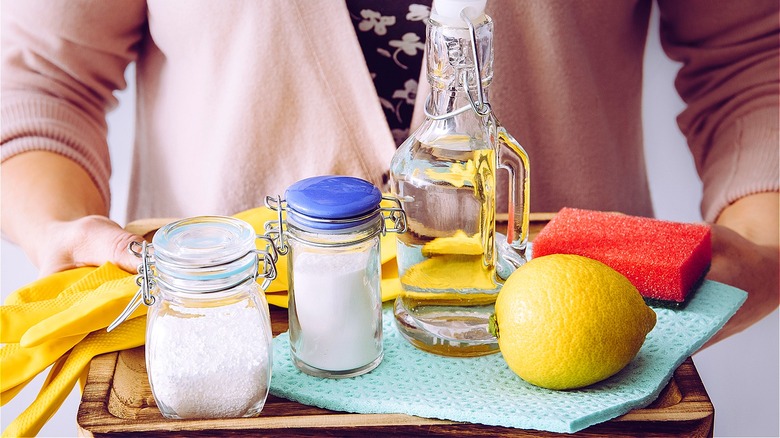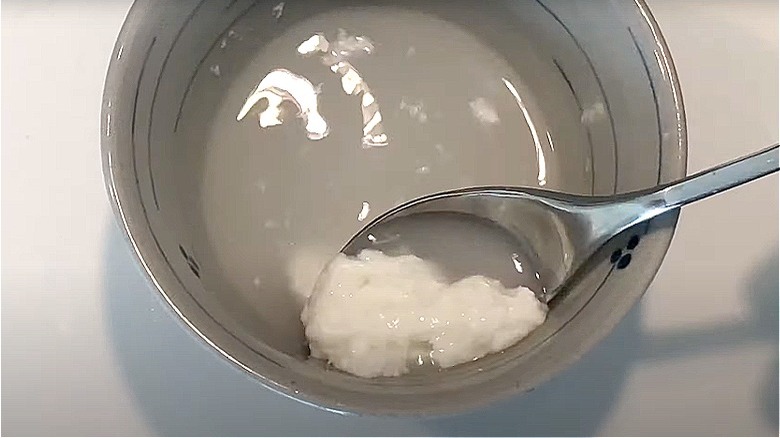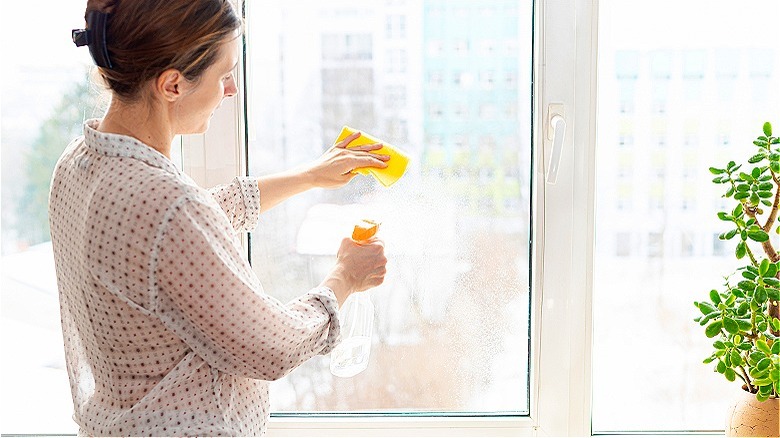The One Cleaning Product You Shouldn't Combine With Vinegar
If the cleaning world handed out awards, vinegar would likely be up there with Katharine Hepburn, Tom Brady, and Beyoncé. Considered by many homeowners as the greatest of all time, the natural ingredient is the ultimate versatile cleaning tool, tackling everything from mold in your fridge to soap scum on shower heads. Vinegar's powers are so legendary some enthusiastic home cleaners think mixing it with another product will make it even better. However, before you start channeling your inner chemist, be aware of one cleaning product you shouldn't combine with vinegar: Castile soap. Doing so negates each item's effectiveness.
When it comes to cleaning, Castile soap's no shrinking violet. The all-natural, vegetable-based soap is free of chemicals, synthetics, and animal products, yet is still able to thoroughly clean everything from skin and hair to toilet bowls and windows, cutting through grease and grime like a ninja, leaving behind shiny sanitized surfaces. What's more, like vinegar, Castile soap is affordable, environmentally friendly, and pet-safe. It's no wonder homeowners the world over are tempted to merge the two superpowers. Unfortunately, if you think combining vinegar and Castile soap will spawn a cleaning megaforce the likes of which the planet has never experienced, prepare to be sorely disappointed. In an ironic twist of fate, mixing the two cleaning giants results in an abysmal concoction that's not only gross to look at, but more importantly, fails to successfully clean anything it touches.
Why you shouldn't combine vinegar and Castile soap
Mixing together Castile soap and vinegar will neither jeopardize your health nor will it trigger a monstrous, house-damaging explosion. Instead, the pairing will simply leave you with a worthless, greasy, white, congealed mess. Chock it up to chemistry. On its own, vinegar is acidic and features a low pH level. It's derived from a fermentation process that combines acetic acid and water. Conversely, Castile soap is alkaline with a high pH level. As such, it's categorized as a base. Combining the two decreases the pH of the soap and increases the pH of the vinegar, essentially rendering each ingredient useless.
While the chemical combo may not produce the same electrifying eruption as mixing Coke and Mentos, a reaction still occurs. Vinegar converts the Castile soap back to its original fats and oils, also known as unsaponified matter. You can witness this natural negation first-hand by adding a little of each substance into a bowl. What you'll see is far from a happy union; rather, the dish will be filled with what looks like curdled milk. Moreover, if you attempt to sanitize anything with the slimy substance, you'll be left wiping up a sticky film containing zero cleaning power. Unfortunately, no matter how committed you are to making the Castile soap-vinegar marriage work, science is against you. Even if you add baking soda (another base) to the Castile soap vinegar mix, you're not guaranteed a successful elevation of cleaning power.
Use vinegar and Castile soap individually rather than together
If you're a die-hard fan of Castile soap and vinegar, don't despair; there's good news. Just because the two biodegradable friends don't play well together, doesn't mean you should nix them from your cleaning arsenal. In the end, Castile soap and vinegar may not work well concurrently; however, they become a dynamic duo when applied consecutively. Simply use the Castile soap to clean per usual, then rinse with vinegar to obtain a sparkly shine.
Regular users of Castile soap know the cleaner often leaves behind a salty residue on hard surfaces. To eliminate this film, hand wash with Castile soap, then dip the dishes in a solution consisting of 1 cup of vinegar to 1 quart of water. You can use the same recipe to create a rinsing agent for countertops, sinks, and tubs coated with the same Castile soap film. Simply add the water and vinegar to a spray bottle, give it a good shake, and spritz on the affected areas.
Additionally, for dirty windows cleaned with Castile soap, follow up with a generous spray of straight vinegar before drying with a microfiber cloth. Just remember to wipe off as much of the Castile soap from the windows before applying the vinegar spray


